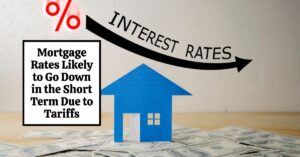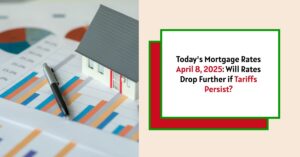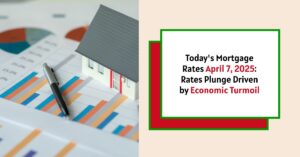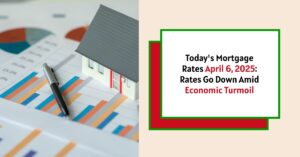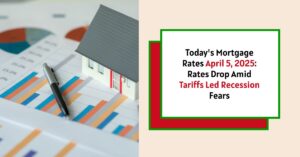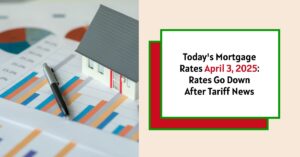Right now, if you're keeping an eye on the housing market, you're probably wondering: Will mortgage rates go down? The short answer, based on recent happenings, is yes, mortgage rates are likely to fall, at least in the short term. However, like that unpredictable weather, the long-term outlook has a lot of clouds of uncertainty. Let's dive into what's causing this current dip and what it might mean for folks looking to buy or refinance a home.
Mortgage Rates Likely to Go Down in the Short Term Due to Tariffs
Why Mortgage Rates Are Heading Down Now?
You might be scratching your head, especially if you heard that the job market is doing pretty well. Usually, a strong economy can actually push interest rates up. So, what's the deal? Well, it boils down to something else entirely: tariffs and the potential for a trade war.
Just recently, there was news about stronger-than-expected job growth. In March of 2025, more jobs were added to the U.S. economy than experts predicted, and the unemployment rate stayed pretty much the same. This kind of news usually suggests a healthy economy, which can sometimes lead to higher interest rates as the Federal Reserve tries to keep things from overheating.
But here's the twist: the financial markets are paying much closer attention to the fallout from new tariffs. Think of tariffs like taxes on goods coming into the country. When these taxes go up, it can lead to higher prices for consumers and businesses. In response to the U.S. announcing these tariffs, other countries, like China, have said they'll put their own tariffs on American goods. This kind of back-and-forth can spook investors because it raises the risk of a slowdown in the global economy, or even a recession.
Tariffs Trump Jobs Data (For Now)
This is why, despite the good news about jobs, mortgage rates are actually falling. When investors get worried about the economy, they often look for safer places to put their money, like U.S. Treasury bonds. When demand for these bonds goes up, their yields (which often influence mortgage rates) tend to go down. So, the worry about the economic impact of these tariffs is pushing down Treasury yields, and in turn, pulling mortgage rates lower.
It's a bit counterintuitive, I know. You'd think a strong job market would be the main driver of interest rates. But right now, the potential economic shock from these trade disputes is overshadowing that.
What This Means for Homebuyers and Owners
For anyone thinking about buying a home, this dip in mortgage rates could be welcome news. Lower rates mean your monthly mortgage payments could be more affordable, and it might even increase how much house you can comfortably afford. It could be a window of opportunity to lock in a lower rate.
If you're already a homeowner, lower mortgage rates might make refinancing your current mortgage an attractive option. Refinancing could potentially lower your monthly payments or allow you to shorten the term of your loan, saving you money on interest over the long haul. It's always a good idea to run the numbers to see if refinancing makes sense for your individual situation.
The Big Question: How Long Will This Last?
Now, here's where things get a bit murky. While mortgage rates are falling right now due to tariff concerns, it's hard to say for sure how long this trend will continue. The future of mortgage rates really hinges on a few key things:
- Will the inflationary effects of tariffs outweigh the recessionary risks? Tariffs can lead to higher prices for goods, which could cause inflation. If inflation becomes a big concern, the Federal Reserve might be inclined to keep interest rates higher. On the other hand, if the trade disputes lead to a significant economic slowdown or recession, the Fed might actually lower rates to try to stimulate the economy.
- How will other countries respond to these tariffs? The more countries that impose retaliatory tariffs, the greater the potential impact on global trade and economic growth. This increased uncertainty could keep downward pressure on interest rates.
- What will the Federal Reserve do? The Fed plays a crucial role in setting monetary policy, including influencing interest rates. Their decisions will depend heavily on the economic data they see and how they interpret the risks posed by the trade situation.
Recommended Read:
Will New Tariffs Actually Lead to Lower Mortgage Rates in 2025?
Will Mortgage Rates Go Down in April 2025? Here's What the Experts Say
Expect High Mortgage Rates Until 2026: Fannie Mae's 2-Year Forecast
My Thoughts on the Road Ahead
Based on what I'm seeing, I believe the current dip in mortgage rates is largely driven by market jitters surrounding the trade situation. While the jobs report showed a strong labor market in the recent past, that data is a bit backward-looking now. The potential impact of widespread tariffs on businesses and consumer spending is a much bigger concern for investors right now.
I wouldn't be surprised to see some continued volatility in mortgage rates in the coming weeks and months. We're in a period of uncertainty, and any new developments on the trade front could quickly shift market sentiment.
- Short-term: I anticipate that concerns about the economic impact of tariffs will continue to put downward pressure on mortgage rates. This could present a good opportunity for those looking to buy or refinance.
- Long-term: The picture is much less clear. If the tariff situation escalates significantly and leads to a noticeable slowdown in economic growth, we could see rates stay lower for longer. However, if the trade disputes are resolved relatively quickly, or if inflation becomes a bigger concern due to the tariffs, rates could start to move back up.
What Should You Do?
If you're in the market to buy a home or refinance, it's crucial to stay informed and be prepared to act if you see an opportunity.
- Keep a close eye on mortgage rate trends. There are many resources online that track daily and weekly mortgage rate movements.
- Talk to a mortgage professional. They can provide personalized advice based on your financial situation and help you understand the different loan options available.
- Be prepared to act quickly. If you see a rate that looks good, don't hesitate too long, as things can change rapidly.
In Conclusion
While a strong jobs report might typically signal upward pressure on interest rates, the current focus is firmly on the potential economic fallout from new tariffs. This has created a situation where mortgage rates will fall in the short term, offering a potential benefit to homebuyers and homeowners looking to refinance. However, the long-term trajectory remains uncertain and will depend on how the trade situation evolves and how the Federal Reserve responds. It's a time to pay close attention to the news and be ready to navigate a potentially volatile market.
Work With Norada, Your Trusted Source for
Real Estate Investment in the U.S.
Investing in turnkey real estate can help you secure consistent returns with fluctuating mortgage rates.
Expand your portfolio confidently, even in a shifting interest rate environment.
Speak with our expert investment counselors (No Obligation):
(800) 611-3060
Also Read:
- Will Mortgage Rates Go Down in 2025: Morgan Stanley's Forecast
- Mortgage Rate Predictions 2025 from 4 Leading Housing Experts
- Mortgage Rates Forecast for the Next 3 Years: 2025 to 2027
- 30-Year Mortgage Rate Forecast for the Next 5 Years
- 15-Year Mortgage Rate Forecast for the Next 5 Years
- Why Are Mortgage Rates Going Up in 2025: Will Rates Drop?
- Why Are Mortgage Rates So High and Predictions for 2025
- Will Mortgage Rates Ever Be 3% Again in the Future?
- Mortgage Rates Predictions for Next 2 Years
- Mortgage Rate Predictions for Next 5 Years
- Mortgage Rate Predictions: Why 2% and 3% Rates are Out of Reach
- How Lower Mortgage Rates Can Save You Thousands?
- How to Get a Low Mortgage Interest Rate?
- Will Mortgage Rates Ever Be 4% Again?
